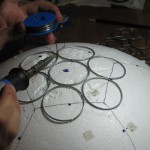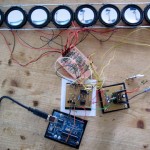Diskokugel is a work in progress, hopefully soon to be finished. For the whole story and latest updates check [here]

0.2beta
I started the project “Diskokugel” in autumn 2009. The vision was to build a ball made of speakers that can be turned on and off individually. This ball would turn while sound would be “reflected” in one constant direction, just like light from a mirrorball. So I went to the [sublab], a hacker space I am co-founder of, and asked for help. I got it galore from Christian, who volunteered to design a circuit that would both be cheap and easy to build.
Meanwhile, I was looking for ways to find cheap speakers.

0.1 alpha
I thought, I could take advantage of the German recycling system, checking the places where people deposit electronic trash, which are administrated locally by the cities. There I was told that it is forbidden for the personnel to let people take some trash, so I wrote a letter to the city to ask if they could grant me access. They told me, that they only administer those places and that the actual trash is owned by some kind of foundation, so they are not allowed to touch it. When I wrote a letter to that foundation, they wrote back that they, too, are not in fact owner of that waste and cannot allow me to take parts of it away to use them, nor could they tell me who to ask. In fact, it would be easier to ask electronics shops, because they are obliged to take in electronic trash and could maybe grant me access to it.

Five boards to run tests
I decided to end my investigations at that point, being afraid to end up in the sicilian sea with concrete shoes. Better not mess with waste management… That made me look for commercial alternatives and led me to the purchase of 1500 chrome speakers from Hangzhou, China. This transaction was preceded by a tiring process of bargaining, exchanging samples, managing shipping costs and import regulations. By the end of that time I had moved to Berlin and the first circuit board from Christian had long been tested.
Now, that the actual size of the speakers (diameter: 50mm) was clear, I started constructing the actual object. I had to find out that my goal to distribute as many circles (speakers) on a sphere as possible is a still unsolved mathematical problem (see [Tammes Problem]. So I ordered a styrofoam ball with the targeted size (40cm in diameter) and started to experiment. I found a solution and later on a mathematical proof that shows that my solution is the most I could make of what I had. It’s 200 speakers on a ball that size. My solution, in the end, was to work with the pattern of a [truncated icosahedron], also known as: soccer ball. This was during the World Championship, of course :) I started soldering.

soldering 0.1 Alpha
I took regular wire you use in the garden and electronic solder and soldered everything on top of the styrofoam ball I had purchased. It took about 3 days to get the first version done, which rolled of my bed and burst into pieces one day later. This wasn’t as unfortunate as one might think, because it was a different pattern than the one I’m using now. Another day of work and the current version was done. I glued speakers to it to have an idea of what it would look like in the end. The result was quite satisfying.

Not pretty. But robust.
The crash of the first model had shown that the ball constructed from wire rings wouldn’t support itself (at least not if it was built the way I did it). There was also still the need to find a place for the required circuit boards. I was looking for some kind of connection from the center to the outside. So I used an icosahedron, connecting each of its 12 corners to the pentagons on the surface. I found a way to solder a more or less exact icosahedron. Actually, I wanted the thing welded for more stability, but a series of unfortunate events (I have a magic talent to break things. It is contagious) led to the return to the good old electronic solder. It’s done.

From the inside you can see the chrome bodies
To increase the sound quality I needed bodies for the speakers. I kept looking for something cheap and convenient such as yoghurt cups until, suddenly, christmas arrived and the solution hung in front of my nose: Christmas balls. The chrome look of these will make it even better.

Speakers, switchboard and Arduino connected.
With the basic construction issues solved, I turned back to the electronics. I programmed an interface in [PD] to interface with the [Arduino] that takes care of the serial communication and controls the switching process. The control circuit has a part built in that synchronizes the switching of speakers with the zero phase of the audio signal. This is supposed to prevent the Speakers from cracking when being switched on or off. Technically, this works perfect, but cracking still occurs. It’s mostly audible when playing pure sine waves or when switching really fast. We are still looking for the source of this and hopefully will resolve the problem soon (or choose to ignore it). Then, a series of circuit boards can be produced and we are close to finishing the whole thing. About time, if you ask me.